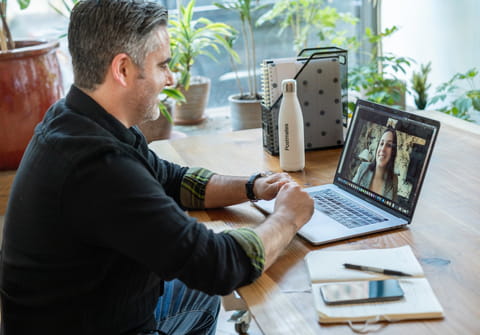Improve video calls: quality, lighting

In these times of social distancing, video calls have become our window to the outside world. Whether for work or for leisure, most of us are using them regularly, if not daily, to communicate with our friends, family, colleagues or our partners. Despite this regularity, many of us are still making simple mistakes that can spoil the quality of our calls. Therefore, in this article we have collated a series of easy, and free (or almost) tips to improve your video calls!
How to improve the connection?
If you are able to connect to the internet via an ethernet connection, prioritise this over relying on a WiFi network, as this will eliminate interference caused by other devices. This option is especially recommended for business meetings or important calls where the connection needs to be at its best.
If this is not possible, and you can only connect wirelessly to a Wi-Fi network, we recommend that you follow these basic rules:
- Stay as close to the router or modem as possible.
- Eliminate possible obstacles that make it difficult to receive the signal (especially if they are made of metal), and try to place the device in an elevated position.
- Keep in mind that the more people are connected to the call, the more the signal must be distributed and the worse your video call will be. This effect is particularly noticeable on some Zoom calls where you can connect with 100 active users.
- For the same reason, make sure that you are not using the internet for other non-urgent activities whilst you make your video conference, such as downloading videos or streaming services, as they will eat up your bandwidth.
Which device is better to use for video calls?
As a general rule, it is preferable to use a laptop or desktop computer to make your video call, as opposed to a smartphone. Typically the image will be of a higher quality and will have a greater stability. Secondly, video call software and applications generally have more comprehensive options than desktop versions than mobile versions. So if you are at home, prioritise the use of your PC.
What are the best apps for video calls?
As you may be aware, there are currently dozens of specialised apps for making video calls. Depending on your intended use, you will be interested in one or another. Due to their quality and reliability, we recommend Skype, Zoom, Google Duo, Google Hangouts Meet, and others with extra privacy such as Webex. And just to reiterate, if you have the possibility to, prioritise the web version.
If you want to know more about the best apps for making video calls, you can check out this article.
What about lighting and camera positioning?
An issue that we often overlook is our personal presentation during video calls. Think carefully about what the other users on the call will see. Especially when it comes to a job interview, or a call with someone you want to make a good impression on. Here are some tips that can help:
- If it is daytime, try to use natural light to your advantage. Stand near a window and in front, not with your back to it, as this will turn you into a shadowy figure! If natural light isn’t an option, consider using an artificial light to illuminate your face (for example an LED spotlight), so that you don’t look like a ghost in front of your camera.
- Also, be careful about what appears in the background, and foreground of your screen before starting the call. Remove anything that will “incriminate” you (such as a messy room, dirty clothes or dishes!), and try to avoid communal areas of your house. This will reduce the risk of your children, partner or roommate making an unexpected appearance in your video call. To reduce the risk, you can sit with your back to a neutral toned wall, or just in a quiet place.
- Bare in mind the placement of your camera. Typically it is below eye level, which doesn’t create the most flattering angle. We recommend that you put a couple of books underneath your laptop to raise it to eye level. Likewise, if you are using your phone, keep it elevated.
How to improve the sound and call quality?
Sound is one of the most important elements of any video call, arguably even more so than the image (unless you planned on playing charades). Therefore, we recommend that whenever you can, use an external microphone, instead of the one integrated in your device as this can help avoid unwanted echos.
Finally, if you notice that your sound quality isn’t too great and keeps cutting out, yet you still have a high video quality, try reducing the video resolution to preserve a better sound. You are better having a clear sound and blurred image, than a perfect image with a broken audio every few seconds.
